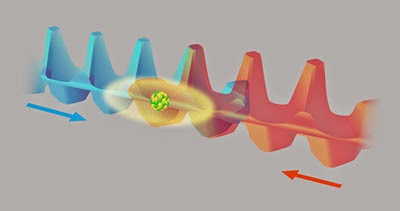In the experimental test by Robens et al., the caesium atom moves in one of two possible optical fields, here indicated in red and blue. The fields have a periodic "egg-carton"-like potential. The authors prepared the atom in a superposition of two atomic states, which was equivalent to the atom simultaneously sitting in the red optical carton and the blue optical carton, and determined the atom's position by detecting its fluorescence as the two cartons were slid apart. (Courtesy: Phys. Rev. X 5 011003)
Topics: Cesium, Macrorealism, Quantum Mechanics, Quantum Random Walks, Quantum Superposition, Superposition
Is there a limit on how large a quantum superposition can be or can macroscopic objects, such as humans or say cats, also exist in a superposition of quantum states? Our daily experience seems to suggest that large objects do not obey the rules of quantum mechanics and are said to behave classically. This suggests that there could be a fundamental boundary between the quantum and classical worlds.
To try and nail down exactly where this boundary lies, researchers in Germany have tracked the motion of a large atom in an optical lattice. They found that the atom moves in a non-classical way, behaving as a quantum superposition that occupies more than one location at any given time.
Boundary conditions
Probing the classical–quantum boundary is currently of great interest to physicists, with a variety of different experiments trying to work out where such a cut-off may lie. Indeed, in the past few years, physicists have been placing ever-larger objects into states of quantum superposition. These are often interference experiments, whereby large molecules are sent through a double slit and made to interfere with themselves.
But in 1985 Anthony Leggett and Anupam Garg took a decidedly different approach to the quest by developing a theory known as "macrorealism". Instead of showing that quantum theory holds, they aimed to show that anything apart from a quantum description would disagree with experimental observations. In explicit contrast with quantum theory, the theorists posited that in the worldview of macroscopic realism, large objects must be in one determinate macroscopic state at any given time, allowing for no superposition or blurriness in the system. Macrorealism has two main criteria: that macroscopic superpositions are not allowed and that it is possible to make a measurement of the system without influencing the system in any way, meaning that you can always measure, say, the location of a large object without disturbing it.
If macrorealism were true, repeated measurements, at different times, of a single macroscopic system would only be statistically correlated up to a certain degree, giving what they called the Leggett–Garg (LG) inequality. The aim then was to violate the inequality with experimental evidence. This is similar to the Bell inequalities, which set out to show that another basic quantum effect, known as entanglement, is indeed possible. The difference is that for Bell's inequalities, the measurements are made at different points in space, while for the LG inequality, the experiments take place at different times. Over the years, a number of experiments on photons, nuclear spins and superconducting circuits have been carried out to violate the LG inequality.
Physics World: Quantum random walks put a limit on superposition
Tushna Commissariat is a reporter for physicsworld.com
Quantum random walks - an introductory overview, Julia Kempe

Comments